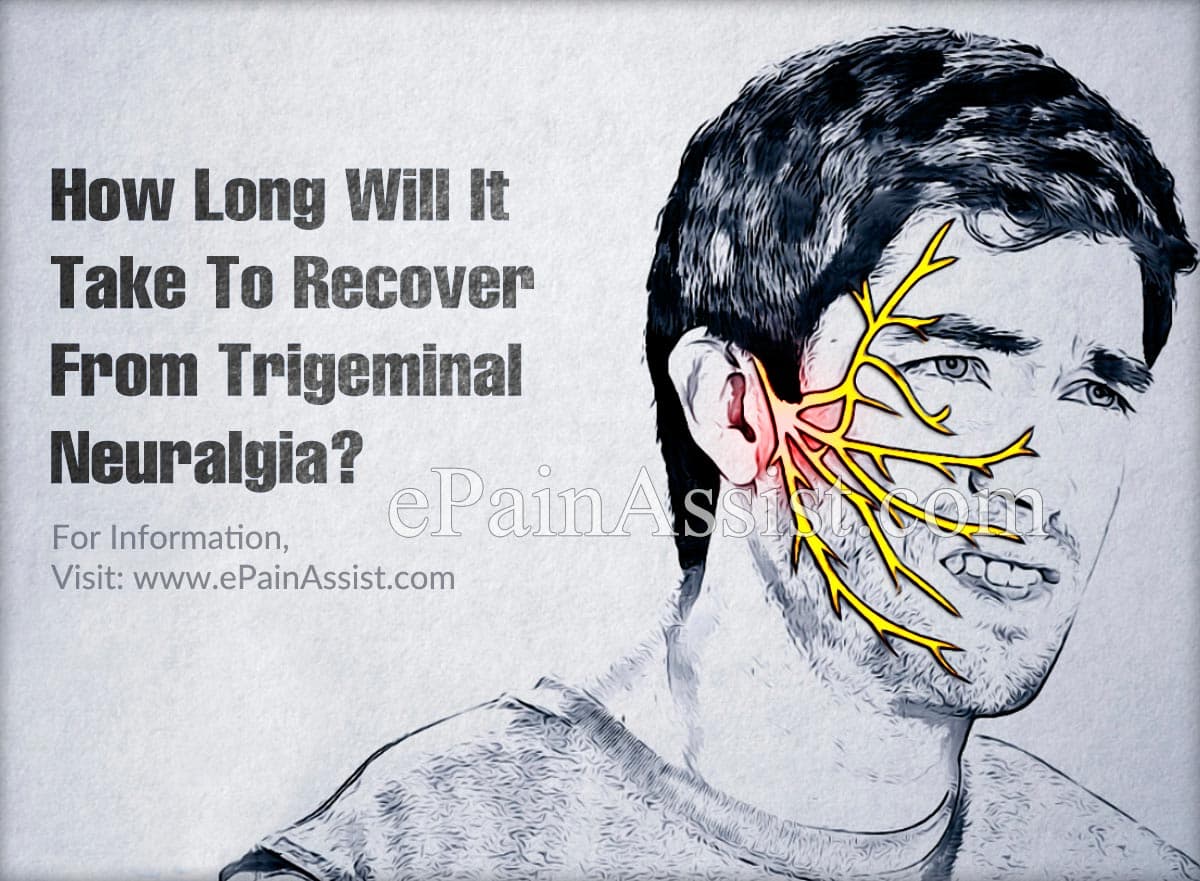Trigeminal neuralgia (TN) is a condition of chronic pain affecting the trigeminal (5th cranial) nerve. The trigeminal nerve is one of the most widely distributed and largest nerves in the head. It is responsible for sensation in the face and motor functions including chewing and biting.[2] There are two major classifications of trigeminal neuralgia namely typical/classical neuralgia (type 1 or TN1) and atypical (type 2 or TN2). The typical form of trigeminal neuralgia is characterized by sudden shock-like facial pain that can last for a few seconds or even for two minutes, on the other hand, the atypical form is characterized by constant aching, burning and stabbing pain. Despite the traits of the type 2 trigeminal neuralgia, its pain is less severe compared to that experienced by patients with type 1 trigeminal neuralgia.[1]

How Long Will It Take To Recover From Trigeminal Neuralgia?
It is unlikely that trigeminal neuralgia will go away on its own. There are times you may experience pain-free periods, but the pain often always returns. Nonetheless, trigeminal neuralgia remission may last for days, weeks, months, and even years. But when the pain does return, one usually experiences lesser and shorter periods of no pain. Trigeminal neuralgia is normally treated with anticonvulsant medication such as Tegretol (carbamazepine), Carbatrol, Trileptal, Lyrica, and Dilantin. When a prescribed medication becomes ineffective, then surgery is considered.
The commonly performed surgery to resolve trigeminal neuralgia is microvascular decompression surgery (MVD). It offers the greatest chance of long-term relief without damaging the nerve and involves the removal of the cause of pain. The procedure involves the removal of a section of your cranial bone to access the inner tissue. From there, the neurosurgeon aims to lift the vessel causing the pain by placing padding between the two i.e. the vessel and trigeminal nerve. It is the most preferred surgical procedure since it has the shortest recovery time.[4]
How Do The Symptoms Of Trigeminal Neuralgia Last?
Episodes of trigeminal neuralgia can occur within a short period of time in quick succession lasting up to two hours. Needless say, at times both forms of trigeminal neuralgia can occur at the same time in an individual, making the pain more intensified and unbearable. Chronic pain affecting the trigeminal nerve can be physically and mentally debilitating. [1] The major symptoms exhibited by patients with trigeminal neuralgia include;
- Severe, jabbing electric-like pain
- Spontaneous pain attacks that may be triggered by activiies such as brushing of teeth, chewing, and even touching the face
- Session of pain attacks that may last for a few seconds up to several minutes that occur for days, weeks, and even months
- A constant aching that evolves into spasm-like pain of the 5th cranial nerve
- Pain in the cheeks, gums, lips, teeth, jaw, and in rare cases, eyes and forehead. The pain often affects one side of the face at a time; it may be localized in one spot or spread out.
These symptoms of trigeminal neuralgia may last for days, weeks, months, or even longer. At first, you may experience short, mild attacks that may increase in number and intensify in pain over time. The chronic pain can progress into frequent bouts of shooting pain, that may overwhelm you whenever they occur. Mostly, the pain attacks will stop for a period of time before reoccurring. But, as the condition progresses and worsens, the interval between attacks lessen. Eventually, the pain-free intervals are almost non-existent, and medication does not help out much with the pain.[3] [1]
Conclusion
The recovery period for each and every individual is different, even in cases where symptoms are shared. For patients with trigeminal neuralgia, it may take weeks, months, or even years to recover. This is all dependent on the treatment plan and the severity of the condition. Those who undergo surgery i.e. microvascular decompression surgery recover much faster compared to patients being treated with medication. When trigeminal neuralgia reoccurs, it is usually more persistent in terms of the interval between pain attacks. But then again, one can be in remission for years, living a pain-free life.
- https://www.ninds.nih.gov/disorders/patient-caregiver-education/fact-sheets/trigeminal-neuralgia-fact-sheet
- https://en.m.wikipedia.org/wiki/Trigeminal_nerve
- https://www.mayoclinic.org/diseases-conditions/trigeminal-neuralgia/symptoms-causes/syc-20353344
- https://fpa-support.org/learn/frequently-asked-questions/
Also Read:
- Is Trigeminal Neuralgia Considered A Disability & Is It A Permanent Problem?
- What Foods Should You Avoid & Eat If You Have Trigeminal Neuralgia?
- What Are The First Symptoms Of Trigeminal Neuralgia & How Do You Test For It?
- Is Trigeminal Neuralgia A Sign Of Multiple Sclerosis & Does It Show Up On MRI?
- What Leads To Trigeminal Neuralgia & Can It Be Cured?
- Coping Methods For Trigeminal Neuralgia
- What Is The Prognosis For Trigeminal Neuralgia?
